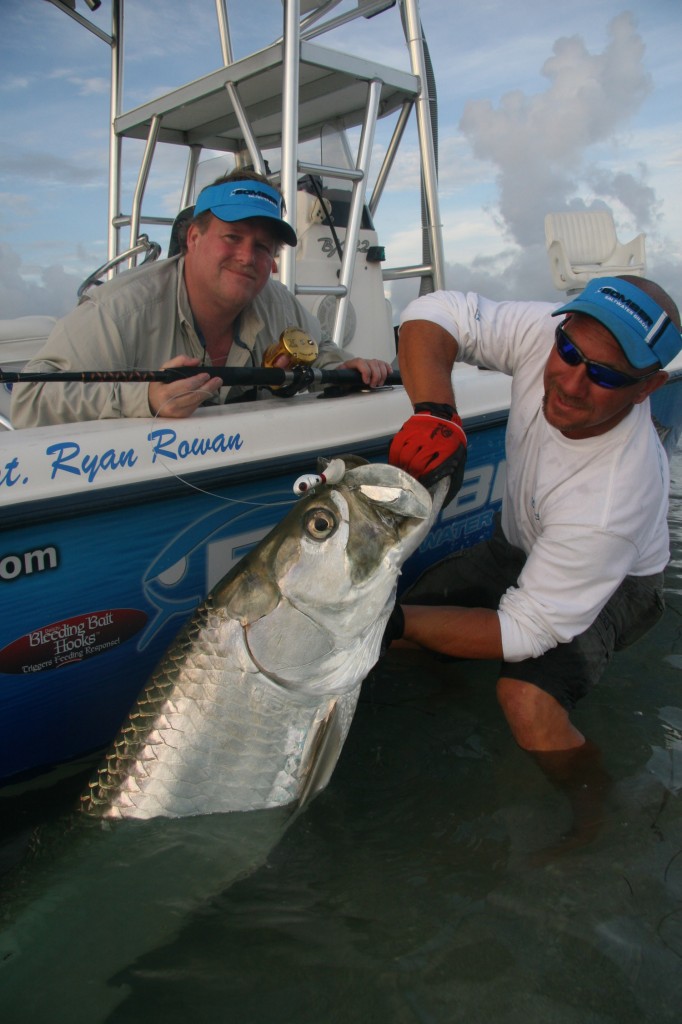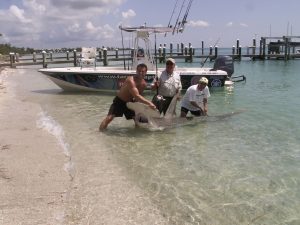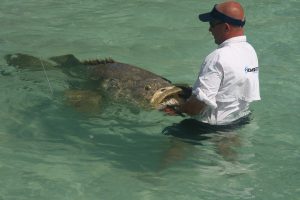July 18, 2012
By Blair Wickstrom
Battle three Florida heavyweights in the same pass.
 Captain Ryan Rowan prepares to revive a modest-size tarpon caught by Russell Garner.
Captain Ryan Rowan prepares to revive a modest-size tarpon caught by Russell Garner.
With a massive, hungry hammerhead behind our 22-foot bay boat, I couldn't help but think we may need a bigger boat. Captain Ryan Rowan had just thrown over a frozen 5-gallon block of mixed water, blood and assorted fish parts, followed by a hooked, bleeding, but live 6-pound stingray.
We stood and watched as the shark zeroed in on the bait, moving back and forth, narrowing and speeding up its side-to-side search. Suddenly the shark disappeared and the clicker on the gunnel-mounted rod came to life. Fish on!
Our day had started with a plan to try for Boca Grande's Big Three: hammerhead shark, tarpon and goliath grouper, a trio whose combined weights could realistically top 2,000 pounds. Ever hear of a One Ton Slam? It's possible, here in Southwest Florida's Boca Grande Pass.
Of course, conservation laws and the sportsman's ethic make it doubtful anyone will ever actually weigh such a collection in a single day, but we can do some quick math from the history books. The great hammerhead shark world record is from Boca Grande, 1,280 pounds, caught in 2006. The all-tackle record for the goliath is 680 pounds, and tarpon 286 pounds.
“There are 1,500-pound hammerheads in the pass every summer,” says Ryan. “I see the same ones every year. There's one with a real black back, I even had him hooked once, it's big, big, big. Probably 1,500 to 1,800 pounds. It's easy to identify these sharks. Without a doubt the legend of ‘Ol' Hitler' is real, I know some of the people who have claimed to have seen it. It's not one I'd want to put a hook into, probably over 2,000 pounds.”
As for the goliath grouper, nowadays the most dependable catch of the slam, there is a pack of fish, maybe more than a hundred-strong, that moves around the old phosphate dock pilings on the north side of the pass.
“There are fish in there that easily exceed the all-tackle record,” says Ryan, “but until you can take possession of the fish to weigh it we'll probably never know exactly how big they are, but I've caught fish that I know exceed 700 pounds.”
The slam wraps up with the “smallest” fish of the three, tarpon, which can top 200 pounds. “Every year someone catches a 200-plus-pounder in the pass,” says Professional Tarpon Tournament Series founder, Joe Mercurio. “This year Artie Price caught a 217-pound fish in one of our tournaments.”
The tournaments in fact weigh some of those catches in a waterside sling; the fish are released immediately after. This may be performed on tarpon to which a $50 “kill tag” has been affixed—though of course few, if any, recreational anglers kill tarpon in Florida these days.
“A few years ago Jeff Cotton caught a fish, well most of a fish, that weighed 187 pounds, and it was only half a fish,” Joe continued. “After a boatside shark attack the remaining front half had a girth measurement that would put the fish's weight over 250 pounds.”
Mentally I sized up the big shark behind Ryan Rowan's boat. A tarpon we'd released earlier that morning was a sardine compared to this monster.
“No; wait!” exclaimed Ryan, as my hand was reaching for the rod. “Let it go, let it go.”
 Hammerhead prior to release. The sharks prey on schooling tarpon.
Hammerhead prior to release. The sharks prey on schooling tarpon.
As line continued to peel off the reel, the clicker keeping it from bird's nesting, I was instructed to take the rod to the bow-mounted fighting chair as Ryan spun the boat around. Just as I sat in the chair Ryan yelled, “put the drag to full,” as he jammed the boat into full reverse, using the combination of the boat and rod to set the hook.
Unfortunately, just as quickly as we hooked up, we lost our fish. As soon as the line came tight, the 100-pound braided line was cut above the 8-foot, 2,100-pound-test aircraft cable.
Everyone was disappointed, but as quickly as we'd hooked up, it seemed getting another one wouldn't be a problem. But this time Ryan put out a longer, 13-foot leader.
Our frozen chumblock was pretty much gone, but we still had the fresh scent of blood trickling into the water from the cut stingrays we had in the livewell. The conditions were the same, we were ready. But no fish.
After about an hour Ryan made the call to head for the phosphate docks and try and get the grouper of the slam. The incoming tide would soon be slack, cooling things down in the pass, but making them ideal for fishing around the pilings.
“The hardest fish of the slam to catch—the most unpredictable—is the shark. They get finicky,” he explained. “The goliath is pretty dependable, and it's a numbers game with the tarpon, where you just have to keep your worm in the pack.”
Joe Mercurio, who sees plenty of shark action while filming his tarpon tournaments, thinks the best place to catch a shark is just outside the pass, on the so-called “pan,” the sandbar just north of the channel.
He recommends anchoring on the bar in 3 to 5 feet of water, where your baits are off the bar in approximately 17 feet. He says your best bet for catching sharks is in May and June, at the start of an outgoing tide. “While chumming I like using a tail-clipped jack or half of a Spanish mackerel,” Joe added.
Ryan's standard shark routine is to set up just to the inside or outside of the pass tarpon anglers. He leaves the boat in gear, facing into the tide with just enough rpm to keep the boat in position. He likes to chum with a frozen block of a mixture of blood, water and small fish parts. “Once the chum is in the water you'll know pretty quickly if the sharks are there,” he says.
Ryan usually fishes just one bait, but putting down two baits, one of them on a float, will definitely help your odds, he says. For the bottom bait there's no reason to add any weight. With 13 feet of cable and a pretty large hook the baits will go down; as for the float rig, a large balloon tied about a foot from the hook keeps your bait pretty close to the surface.
Most of the time you're fishing in 40 to 50 feet of water so you don't have to let out much line. Simply release the drag, leave the clicker on, and let out 20 to 30 feet of line.
Another technique Ryan uses to catch sharks is one that pass anglers appreciate. “Whenever the tarpon guys see me with my shark rigs out, it always draws a smile,” says Ryan. “My phone rings off the hook. The common call, on the VHF or cell, ‘Shark, shark, Ryan, over here.'
“The sharks seem to know when to strike a hooked tarpon. They sense when the fish is tired out, toward the end of the fight, and attack. But running and gunning on reports of shark attacks is probably more exciting than effective.
“The bulls are the most aggressive, but there's definitely a pecking order. Once you see the bulls disappear you know there's a big hammer in the area,” Ryan says, grinning.
It was still early in the day, the slam still within our grasp. Crewmate Russell Garner had a tarpon to his credit; now it was time for him to battle a super-size dock grouper. Ryan exchanged the Penn International 80s for International 50s; not much downsizing here, or in the rigging, where, instead of going with 100-pound braid, we were armed with 400-pound mono.
As we headed to the long stretch of dock pilings leading from shore, remains of the old phosphate docks, I could sense a renewed confidence in Ryan. He handed me a small jack crevalle pinned to the 1,200-pound cable with a 13/0 Mustad hook. When the nose of the boat was nearly touching one of the pilings he instructed me to lower the bait to the bottom.
While still holding the bait, the cable was pulled from my hand, signaling Ryan to slam the boat in reverse, while Russell was told to reel. I was glad we were somewhat prepared. Even then I wasn't sure we were going to keep Russell in the boat. If he hadn't had his feet wedged up against the toe-rail of the bow I think Russell may have been pulled in.
This was a brute tug-of-war. With the help of the boat getting the large fish away from the pilings, success was a matter of whether Russell's back and arms would hold up. Lift and wind. Lift and wind.
Wearing a harness, Russell took the fight to the fish from a fighting chair thru-bolted to the deck. That made fighting, and catching, the 300-pound goliath doable. Keeping constant pressure on the fish is key.
You can go after these fish without bow-mounted fighting chairs, but I'd want a standup harness and good friend to hold on to me.
With two-thirds of our slam caught, and the tide beginning to flow again, Ryan felt we still had a good shot at catching a shark.
Readying the 80s for battle, Ryan quickly started networking with his friends in the pass, making sure everyone knew we were looking for sharks again. Pretty soon the VHF was clattering, “Ryan, over here…Ryan, outside by the buoy….Ryan, near the beach.” Unfortunately after repeated attempts of throwing a fresh chunk of stingray into three different tarpon-shark encounters it seemed we weren't going to be successful catching our slam in a single day.
But when you aspire to measure your catch by the ton, and you get even a quarter of the way there, it's still a pretty good day fishing in my book.
 Goliath grouper gets a refreshing swim before release. Don't try to take these big fish in your boat.
Goliath grouper gets a refreshing swim before release. Don't try to take these big fish in your boat.
Boca Grande Tarpon Fishing
Boca Grande Pass in Lee County is without doubt the most famous tarpon fishery in Florida, if not the world. We've covered the ins and outs of the fishing season and techniques in Florida Sportsman annually since the early 1970s, when the fleet was predominantly made up of livebait fishermen.
Today, a great many Boca Grande anglers favor jigging with standup tackle. Captain Ryan Rowan's setup is typical of that school. When Russell Garner and I joined him last spring, we fished light but strong jigging rods and 4/0 size Penn International Torque reels spooled with 50-pound mono and six feet of 80-pound flourocarbon leader.
All three of us had a different color 5-ounce jig. “Different colors work some of the time; tiger-striped green works all of the time,” says Ryan.
Three is the magic number, as regulations made by the Florida Fish and Wildlife Conservation Commission stipulate that no more than three lines may be actively fished aboard the same vessel in Boca Grande Pass during the months of April, May and June. In addition, jigs and sinkers may not be rigged in such a manner that they fall off, or “break away,” from the hook during the fight.
The key to jig fishing is using your boat engine to keep your line straight up and down, while using your depth recorder to find the fish and stay in them. You'll need to be constantly shifting your engine in and out of gear not only to keep the line straight, but to avoid other boats.
Fishing “The Pass” isn't for the timid. At times it's more like bumper cars in rush hour traffic, full of confusion and hot tempers. But for the most part people get along. “If you've never fished the Pass before, I'd suggest you sit outside the pack of boats and watch for half an hour or so before jumping in. Watch how the boats work the drift and when and where they're dropping and picking up their baits, as well as what they do after they get a fish on,” advises Ryan.
After hooking up on our second drift, Russell made his way to the bow-mounted fighting chair and Ryan quickly got the boat as close to the fish as possible, allowing us to safely get outside the pack, and towards open water. Once free of boats, the fight became manageable and we landed the first third of our One-Ton Slam.
Originally Published in Florida Sportsman Magazine, March, 2010.
Click Here to Have Florida Sportsman Magazine Delivered to Your Home.

